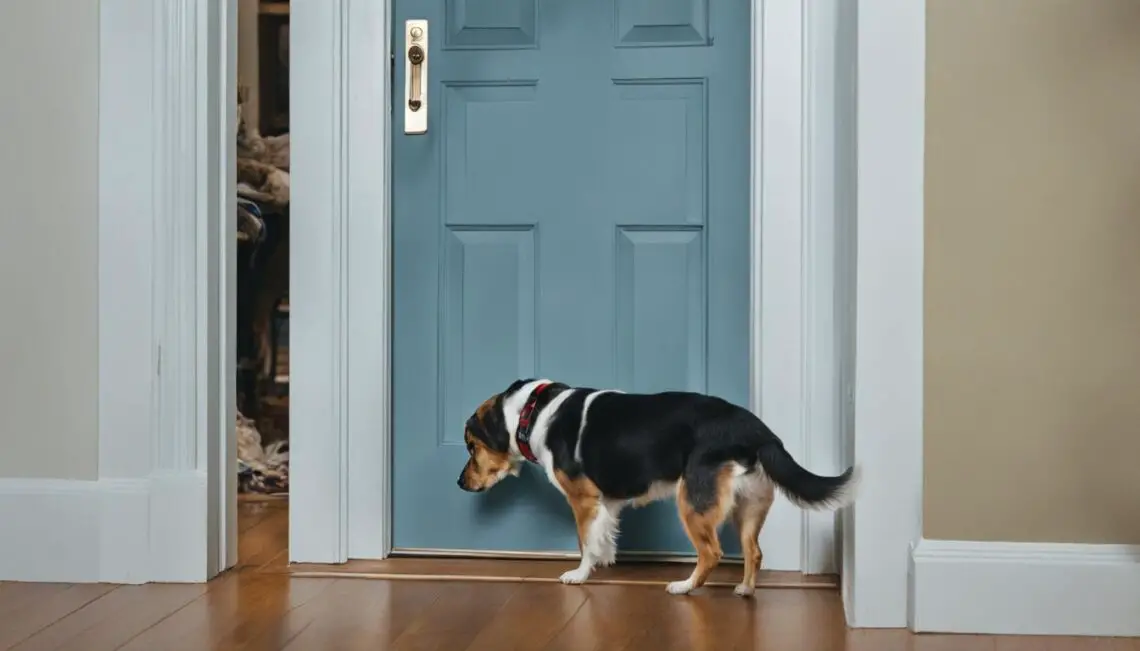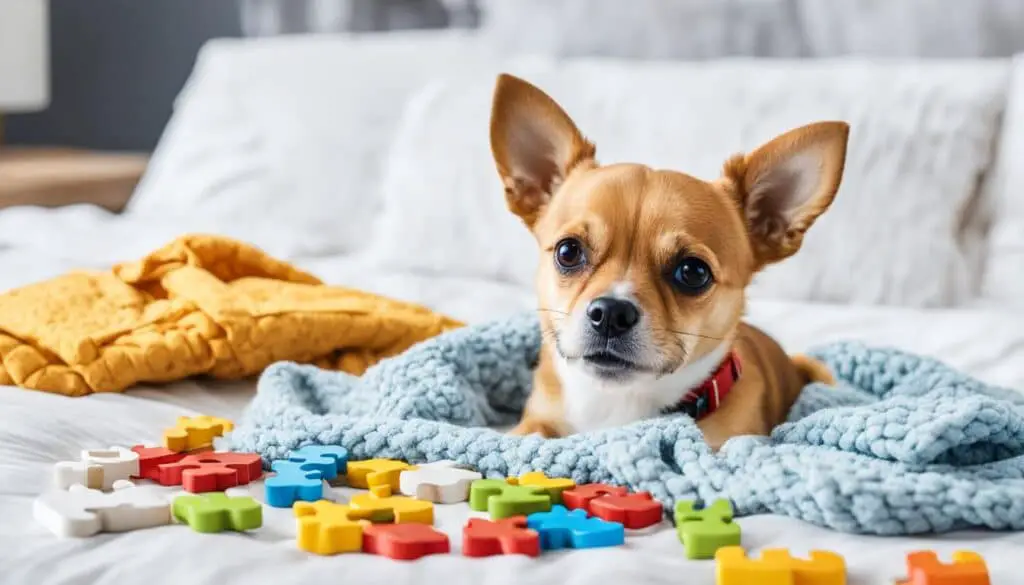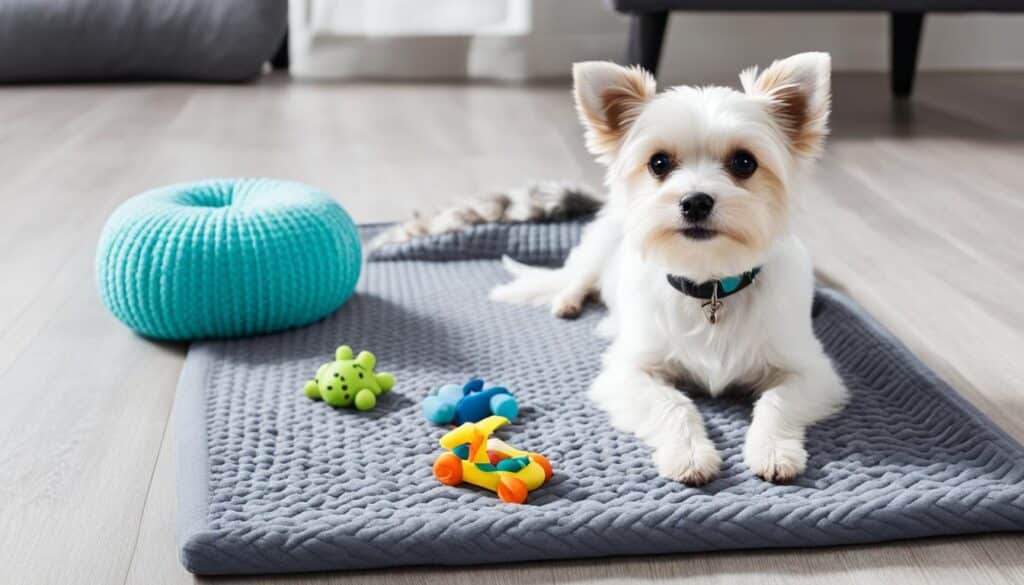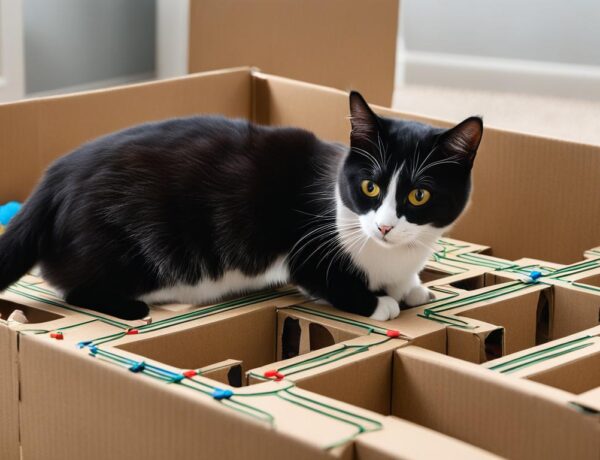I understand the challenges that come with handling separation anxiety in small dogs. It can be distressing for both the dog and the owner when their furry companion becomes overly attached and experiences high levels of stress when left alone. But fear not, there are effective ways to address and manage this issue.
In this article, I will discuss the causes and symptoms of separation anxiety in small dogs, as well as steps you can take to help your precious pup feel more at ease when you’re not around. We’ll explore training techniques, environmental enrichment, and more, so that you can provide a happier and calmer life for your small dog.
Key Takeaways:
- Separation anxiety in small dogs can lead to destructive behavior and distress for both the dog and the owner.
- Causes of separation anxiety can include being left alone for the first time, changes in ownership or routine, and loss of a family member.
- Dogs with separation anxiety may exhibit symptoms such as excessive barking, indoor accidents, destructive behavior, and attempts to escape.
- Establishing a predictable routine, providing mental stimulation, and practicing gradual desensitization can help manage separation anxiety.
- Enriching your dog’s environment with interactive toys, designated relaxation areas, and positive socialization can reduce separation anxiety.
Causes and Symptoms of Separation Anxiety
Separation anxiety in small dogs can be triggered by various factors, leading to distressing symptoms. Understanding the causes and recognizing the signs of separation anxiety is crucial in addressing this issue effectively.
Causes of Separation Anxiety
Several factors contribute to the development of separation anxiety in small dogs:
- Being left alone for the first time: Dogs who have never experienced being left alone may struggle to cope with the sudden absence of their owners.
- Changes in ownership or routine: A dog transitioning to a new home or experiencing significant changes in their daily routine can become anxious when separated from their familiar environment and routine.
- Loss of a family member: The passing or separation of a family member, including humans or other pets, can be a significant trigger for separation anxiety in dogs.
These factors can disrupt a dog’s sense of security and contribute to their anxiety when separated from their owners.
Symptoms of Separation Anxiety
Dogs with separation anxiety may exhibit a range of distressing symptoms:
- Excessive barking: Dogs may bark excessively when left alone as a response to their anxiety and distress.
- Indoor accidents: Urinating or defecating inside the house, even when housetrained, can be a sign of separation anxiety.
- Destructive behavior: Dogs may engage in destructive behaviors, such as chewing furniture or belongings, in an attempt to cope with their anxiety.
- Excessive drooling or panting: Anxiety can cause dogs to drool excessively or pant excessively, even when not physically active.
- Pacing: Dogs with separation anxiety often exhibit repetitive pacing behavior as a way to relieve their anxiety and restlessness.
- Attempts to escape: Dogs may attempt to escape from confinement when experiencing separation anxiety, which can lead to injuries or property damage.
Recognizing these symptoms is important to address separation anxiety and provide appropriate support to small dogs.
Steps to Take to Help Dogs with Separation Anxiety
Managing separation anxiety in small dogs requires a proactive approach to help them feel more comfortable and secure when left alone. Here are some effective tips for dealing with separation anxiety:
- Establish a predictable routine and environment for your dog: Dogs thrive on consistency, so establish a daily routine that includes regular exercise, mental stimulation, and a designated area for relaxation. This helps create a sense of security and reduces anxiety.
- Utilize counterconditioning techniques: Counterconditioning involves associating being alone with positive experiences. Offer special treats or toys that your dog loves and only give them when you’re about to leave. This helps create a positive association with being alone and can gradually reduce anxiety.
- Practice gradual desensitization: Gradually expose your dog to periods of alone time to help them become more comfortable with being separated from you. Start with short periods and gradually increase the duration over time. This helps desensitize them to your departures and reduces anxiety.
- Provide mental stimulation: Mental stimulation is crucial for dogs with separation anxiety. Use interactive toys, puzzle toys filled with treats, or food-dispensing toys to keep them occupied and engaged. This helps redirect their focus and keeps their minds stimulated.
- Consider medication or natural remedies: In severe cases of separation anxiety, medication prescribed by a veterinarian may be necessary. Additionally, natural remedies such as calming supplements or aromatherapy can help reduce anxiety levels. Consult with a professional to determine the best course of action for your dog.
Remember that managing separation anxiety takes time, patience, and consistency. Each dog is unique, so it’s essential to tailor your approach to their specific needs. By implementing these tips and working closely with your veterinarian or a professional trainer, you can help your furry friend overcome separation anxiety and enjoy a happier, more relaxed life.
Environmental Enrichment for Dogs with Separation Anxiety
Providing an enriched environment for your dog is key in reducing separation anxiety. By implementing various enrichment activities, you can help alleviate your dog’s anxiety and provide them with mental and physical stimulation.
Interactive Toys
Offering interactive toys is a great way to keep your dog engaged and distracted when you’re not around. These toys typically involve treat dispensers or puzzle features that require your dog to work for their reward. Not only does this keep them mentally stimulated, but it also helps redirect their focus away from separation anxiety.
Daily Exercise
Regular exercise is essential for dogs with separation anxiety. Engaging in daily physical activity helps burn off excess energy and promotes relaxation. Whether it’s going for a brisk walk, playing fetch, or participating in agility training, finding activities that your dog enjoys can help reduce their anxiety levels.
Designated Relaxation Area
Creating a specific area for your dog to relax can provide them with a sense of security and comfort. This area should be cozy and secluded, away from any distractions or noise. You can enhance the relaxing environment by placing familiar items such as their bed, blankets, or even your recently worn clothes with your scent.
Aromatherapy and Calming Scents
Using aromatherapy or calming scents can have a soothing effect on dogs with separation anxiety. Lavender, chamomile, and other relaxing scents can help create a calming atmosphere in their designated relaxation area. Be sure to use pet-safe products and consult with a veterinarian about the best options for your dog.
Socialization and Positive Interactions
Providing opportunities for socialization and positive interactions is crucial for dogs with separation anxiety. Organize playdates with other friendly dogs, visit dog parks, or enroll them in training classes to encourage positive social experiences. Ensuring your dog has a healthy social life can help build their confidence and overall well-being.
By incorporating these enrichment activities into your dog’s routine, you can help reduce their separation anxiety and create a more fulfilling and enjoyable life for them.
Training Techniques for Dogs with Separation Anxiety
When it comes to helping small dogs with separation anxiety, behavior modification techniques can be highly effective. By implementing the right training methods, you can gradually reduce your dog’s anxiety and help them feel more comfortable when left alone.
One of the key techniques is teaching your dog to settle and relax on cue. This involves training them to respond to a specific command or signal that indicates it’s time to calm down and stay in one place. With regular practice, your dog will learn to associate this cue with a sense of security, helping to alleviate their anxiety.
“Training your dog to settle and relax on cue can provide them with a sense of security, reducing their separation anxiety.”
Positive reinforcement plays a crucial role in behavior modification for separation anxiety. Whenever your dog displays calm and independent behavior, make sure to reward them with praise, treats, or their favorite toy. This reinforces the positive behavior, encouraging them to repeat it in the future.
Another important aspect is gradually increasing the duration of time that your dog can be left alone. Start with short periods and gradually extend the time as your dog becomes more comfortable. This gradual approach helps them build confidence and reduces their reliance on constant human presence.
It’s crucial to avoid reinforcing attention-seeking behaviors, as this can worsen separation anxiety. Instead, focus on rewarding your dog for independent and relaxed behavior. This sends a clear message that calmness is rewarding and reinforces the idea that they can cope with being alone.
“Rewarding independent and relaxed behavior helps your dog understand that calmness is rewarding and reinforces their confidence in coping with being alone.”
While implementing these techniques can be beneficial, consulting with a professional dog trainer or animal behaviorist is highly recommended. They can provide guidance tailored to your dog’s specific needs, identify any underlying issues, and offer specialized training techniques.
By using training methods for separation anxiety and focusing on behavior modification, you can help your small dog overcome their separation anxiety and foster a more relaxed and independent mindset. With consistent training and plenty of patience, you can provide your furry friend with the tools they need to feel more secure when you’re not around.
| Training Techniques for Dogs with Separation Anxiety | Benefits |
|---|---|
| Teaching your dog to settle and relax on cue | – Provides a sense of security – Reduces anxiety levels – Allows for independent coping |
| Positive reinforcement for calm and independent behavior | – Reinforces desirable behavior – Encourages repetition – Strengthens the bond |
| Gradually increasing alone time | – Builds confidence – Reduces reliance – Develops independence |
| Avoiding reinforcement of attention-seeking behaviors | – Promotes calmness – Discourages anxiety escalation – Encourages coping mechanisms |
| Consulting with a professional trainer or behaviorist | – Tailored guidance – Specialized techniques – Expert support |
Conclusion
Managing separation anxiety in small dogs can be a challenging journey, but with the right strategies and training techniques, it is possible to help your furry friend feel more comfortable and less anxious when left alone. By understanding the causes and symptoms of separation anxiety, you can take proactive steps to address this issue.
Implementing techniques such as counterconditioning, desensitization, and environmental enrichment can significantly contribute to reducing separation anxiety in small dogs. Through consistent efforts, you can create a supportive and predictable environment for your dog, providing them with the tools they need to cope with their anxiety.
Remember to consult with a veterinarian or professional trainer who specializes in separation anxiety to develop a personalized plan for your dog. They can offer expert guidance and tailor the training techniques to your dog’s individual needs. With patience, dedication, and a compassionate approach, you can help your small dog lead a happier and calmer life.
FAQ
What is separation anxiety in small dogs?
Separation anxiety in small dogs is a common issue where a dog becomes overly attached to their owner and experiences high levels of stress when left alone.
What are the causes of separation anxiety in small dogs?
Several factors can contribute to the development of separation anxiety in small dogs, including being left alone for the first time, changes in ownership or routine, and the loss of a family member.
What are the symptoms of separation anxiety in small dogs?
Dogs with separation anxiety may exhibit symptoms such as excessive barking, indoor accidents, destructive behavior, excessive drooling or panting, pacing, and attempts to escape.
How can I manage separation anxiety in my small dog?
Strategies to manage separation anxiety in small dogs include establishing a predictable routine and environment, counterconditioning, gradual desensitization, and providing an enriched environment.
What can I do to reduce separation anxiety in my small dog?
To reduce separation anxiety, you can provide interactive toys, puzzle toys filled with treats, daily mental and physical exercise, designated relaxation areas, and comforting items like clothes with your scent.
Are there any training techniques for dogs with separation anxiety?
Yes, behavior modification techniques such as teaching your dog to settle and relax, positive reinforcement for calm behavior, and gradually increasing alone time can be effective in addressing separation anxiety.
Can I get professional help for managing my dog’s separation anxiety?
Yes, consulting with a professional dog trainer or animal behaviorist can provide guidance and specialized training techniques tailored to your dog’s specific needs.







No Comments